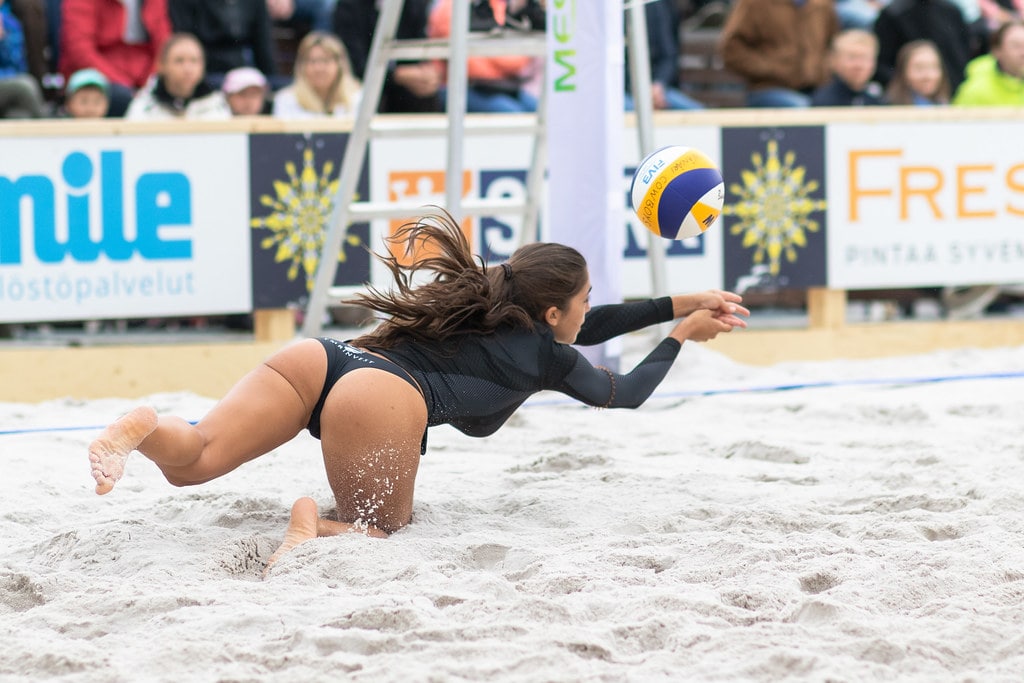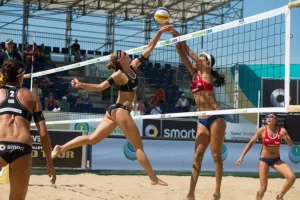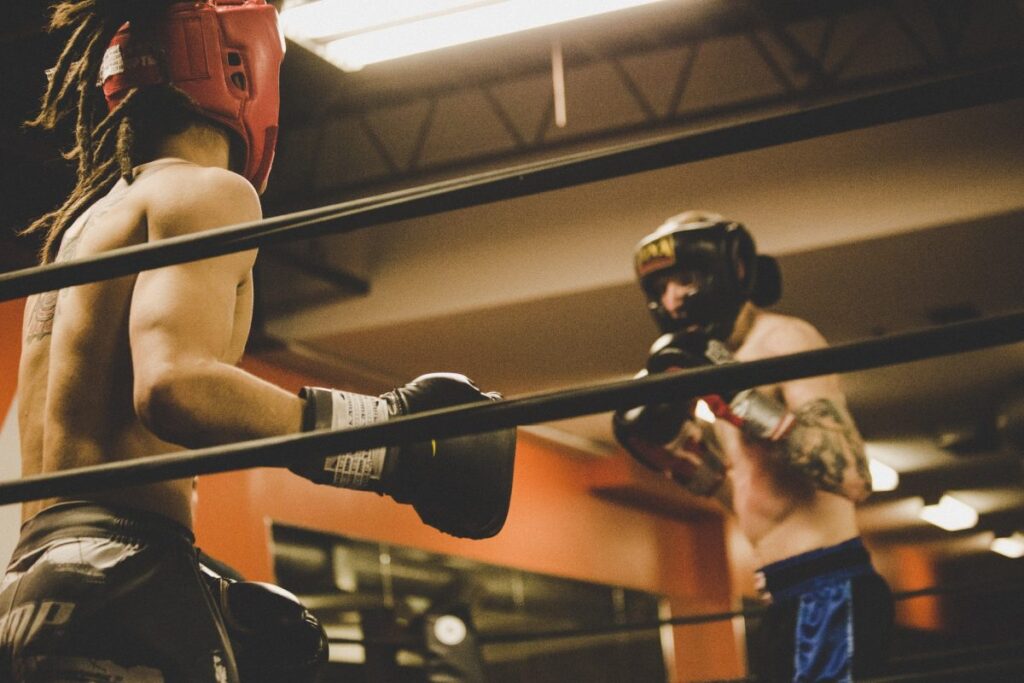
Beach volleyball is an exciting sport played on sandy beaches, but understanding the hardness of the ball is essential to getting the most out of it .
At first glance, beach volleyball and regular volleyball may seem similar, but there is actually a big difference in the hardness of the balls used.
Many people are curious about how this difference affects the feel and strategy of play, and why beach volleyballs are designed with a certain firmness.
In this article, we will take a deep dive into the difference in hardness between beach volleyball and regular volleyball, and explain the reasons behind it and how it affects play.
目次
What is beach volleyball?
Beach volleyball is a dynamic sport played between two players on a sandy beach.
Although this game is a variation of volleyball, it is loved all over the world for its unique rules and play style.
There are some important differences between beach volleyball and regular volleyball (indoor volleyball).
Differences in coats
The beach volleyball court is set up on the sandy beach and measures 16 meters x 8 meters.
This is smaller than an indoor volleyball court, which is 18 meters by 9 meters.
The sandy surface is flexible for players, making it easier for them to jump and dive.
Differences in team composition
Indoor volleyball is generally played with six players, but beach volleyball is played with two players.
This requires players to cover more space on the court and master all techniques (serving, receiving, spiking, blocking, etc.).
difference between balls
Balls for beach volleyball are designed to be slightly larger than those for indoor volleyball and have a softer outer shell.
This is a good characteristic for playing on sandy beaches and makes the ball easier to handle.
Differences in rules
Beach volleyball has some rules that indoor volleyball does not have.
For example, in beach volleyball, the use of the fingers when hitting the ball is severely restricted.
In addition, the number of sets in beach volleyball is usually three-set matches, and the third set is often scored at 15 points.
Differences in equipment
Instead of wearing fixed shoes like indoor volleyball players, beach volleyball players go barefoot or wear sand socks.
This allows you to feel the sand directly for better grip and movement.
These differences make beach volleyball a sport that requires unique strategies and techniques, and requires high levels of athletic ability and teamwork from players.
Because of its charm and uniqueness, beach volleyball has become a popular sport at international competitions, including the Olympics.

Hardness of the ball used in beach volleyball
Beach volleyball uses a ball specifically designed for its unique environment and style of play.
These balls generally have a softer outer shell and lower air pressure than those used for indoor volleyball.
The hardness of beach volleyball, or air pressure, has a large effect on play and greatly shapes the characteristics of the game.
Characteristics of beach volleyball hardness
The recommended air pressure for beach volleyball is 0.175 to 0.225 kgf/cm² (kilogram force per square centimeter), which is much lower than the air pressure for indoor volleyball balls, which is 0.300 to 0.325 kgf/cm².
This lower air pressure makes the ball softer, reducing the impact when players hit it and making it easier to control.
Impact on play
-
Improved Ball Control : The softness of beach volleyball makes it easier for players to apply more precision and force to the ball. This allows you to place it exactly where you want it, making tactical play easier.
-
Continuation of rallies : Soft balls tend to last longer in rallies because they are easier for opponents to receive, despite hard spikes and powerful serves. This makes the matches more competitive and appealing to the audience.
-
Reduced risk of injury : The softness of beach volleyball reduces the impact of the ball hitting your body during play. This helps reduce the risk of injury, especially in the case of a direct hit to the face or head.
-
Suitability for playing on sandy beaches : Sandy beaches are unstable surfaces that restrict player movement. A soft ball is easier to handle in these environments and helps maintain quality of play.
Summary of hardness of balls used in beach volleyball
The hardness of beach volleyball, or its unique softness, is extremely important for players to perform at their best in the unique environment of a sandy beach.
Beach volleyball has its own unique appeal compared to indoor volleyball in terms of improved control, increased rallies, reduced risk of injury, and suitability for sandy beaches.
These characteristics make beach volleyball a unique sport that is loved all over the world.

Comparison with regular volleyball
Regular volleyball (indoor volleyball) and beach volleyball are not only played in different environments, but there is also a big difference in the hardness of the balls used.
Understanding how the differences in the hardness of these two balls affect the characteristics of each sport and the performance of players will lead to a deeper understanding of both sports.
Difference in hardness between volleyball and beach volleyball
-
Indoor volleyball : Normal volleyball air pressure is set at 0.30-0.325 kgf/cm² (kilogram force/square centimeter). This stiffness allows for fast indoor play and powerful spikes.
-
Beach Volleyball : The recommended air pressure for beach volleyball is 0.175-0.225 kgf/cm², which is significantly lower than for indoor volleyball. This lower stiffness is optimized for play on sand, promoting ball control and sustained rallies.
Why the difference matters
-
Nature of Play : Indoor volleyball is characterized by a fast tempo and powerful attacks, while beach volleyball is more focused on tactics and technique. The hardness of the ball reflects these characteristics, allowing optimal play in each environment.
-
Player Safety : One of the reasons beach volleyball balls are soft is with player safety in mind. The soft ball cushions the impact, especially to the face and head, reducing the risk of injury.
-
Ease of Control : Beach volleyball emphasizes ease of control, as players’ movements are restricted on a sandy beach. The soft ball makes it easier to perform precision shots and techniques.
-
Adaptation to the environment : The ball reacts very differently indoors than on the beach. The hardness of each ball is adjusted to adapt to its environment, providing the best playing experience.
The difference in ball hardness between beach volleyball and indoor volleyball is not just a technical aspect, but an important factor in maximizing player experience, safety, and the appeal of the sport.
By understanding these differences, players can hone their skills to suit their environment and improve their performance while having fun.

Why beach volleyball is soft
The reason beach volleyball is designed to be softer than regular volleyball is rooted in its unique playing environment and competitive nature.
Beach volleyball takes place on a sandy beach and is often played in two-person format, so it has to meet a different set of demands than indoor volleyball.
Below we explain why beach volleyball is soft and how it is suitable for playing on the beach.
Player safety
The softness of beach volleyball is designed with player safety in mind.
In beach volleyball, players often get hit in the head or face, and a soft ball cushions the impact and reduces the risk of injury.
This is a very important characteristic as diving and intense play on the sand is common.
nature of the game
Beach volleyball is intentionally designed to be soft to make it easier to maintain rallies.
A soft ball is easier to control, making it easier for players to develop technical plays.
For this reason, strategy and skill play an important role in beach volleyball matches, which often feature longer rallies and technical plays.
Adaptation to the environment
A sandy beach is an unstable, soft surface that is very different from a hard floor indoors.
Soft balls are suitable for play on such surfaces and are designed for jumping and movement on sand.
The softness of the ball allows it to react more predictably on uneven ground, making it easier for players to strategize.
Improved overall playing experience
The softness of beach volleyball is designed to promote fun of the game and competition between players.
By using a soft ball, players can concentrate more on the ball and use technical plays and strategies to compete with their opponents.
In this way, the softness of beach volleyball makes the game more accessible and fun.
The characteristics of beach volleyball are optimized for its playing environment, and a soft ball is a key element to provide a better experience for players.
Beach volleyball is uniquely designed to improve safety, the nature of the game, adaptation to the environment, and overall playing experience.

Impact on players
The impact of beach volleyball’s hardness on players’ technique and strategy is noticeable in each aspect of the game.
Here, we will explore how hardness affects player performance through specific examples.
serve and receive
-
Serve : A soft beach volleyball allows players to put more spin on the ball when serving. Compared to a hard ball, a soft ball is easier to control with your palm, making it easier to hit a tactical serve.
-
Receive : A soft ball reduces the impact when receiving, making it easier to control. This allows players to make accurate receptions and quick setups, making for a smooth transition into attack.
spikes and blocks
-
Spikes : A soft beach volleyball makes it easier for players to hit the ball with strong spikes. The ball feels like it sticks to your hand, allowing you to hit it exactly where you want.
-
Blocking : When blocking, a soft ball is less likely to impact the hand, allowing players to be more aggressive in their attempts to block. Also, it is important to read the movement of the ball and place your hands in the appropriate position, which tests the blocker’s skills.
strategy and communication
-
Strategy : The softness of beach volleyball gives players the opportunity to develop delicate strategies. For example, if your opponent has a strong defense, you can use a soft ball to play with your opponent with short balls or cut shots.
-
Communication : In two-person beach volleyball, the ease of handling the ball improves the quality of communication within the team. Close cooperation between players is directly linked to improving the accuracy of attacks.
The hardness of beach volleyball deeply affects not only the players’ technical ability, but also their tactical thinking and teamwork.
By understanding the characteristics of the ball and incorporating them into their skill sets and strategies, players can maximize the appeal of beach volleyball as a sport.

How to choose and things to keep in mind
When choosing beach volleyball, you should consider several important points to get the optimal playing experience.
Also, proper storage and maintenance are essential to maintain the quality of the ball over a long period of time.
How to choose beach volleyball
-
Check official size and weight : The official size according to the Fédération Internationale de Volleyball (FIVB) is 66-68 cm in circumference and 260-280 g in weight. When using a ball for competitions, it is important to choose a ball that meets this standard.
-
Materials and Texture : Beach volleyballs are generally made of soft materials, but each ball has a different feel and grip. If possible, try it out and choose the one that feels comfortable in your hand.
-
Durability : It’s important to choose a ball that is water resistant and durable to withstand use on the sand. Higher quality balls will last longer and provide better performance over a longer period of time.
-
Brand and Reputation : Buying from a trusted brand gives you peace of mind when it comes to quality. Also, check out reviews and ratings to hear what other players have to say.
Precautions for storage and maintenance
-
Avoid direct sunlight : Store the ball out of direct sunlight and in a place with stable temperatures. Prolonged exposure to heat and UV rays will cause the ball material to deteriorate easily.
-
Maintain proper air pressure : It is important to maintain the recommended air pressure even when not in use. If the air pressure is too low, it will cause it to lose its shape, and if it is too high, it will put stress on the material.
-
Regular cleaning : Gently wipe away sand and dirt with a damp cloth. If necessary, you can use a small amount of neutral detergent, but be sure to wipe off the detergent with a damp cloth afterwards.
-
Be careful not to overinflate : When inflating, be careful not to make the ball too hard. Too much air can have a negative effect on the ball’s performance.
By considering these points when choosing a beach volleyball, you can find the ball that is best for you.
Proper storage and maintenance will also allow you to continue using your ball for a long time.

summary
When choosing a beach volleyball, it is important to choose from official size and weight, material texture, durability, and a trusted brand.
The characteristics of the ball greatly affect the player’s technique and strategy, so choosing the ball that suits you is the key to enjoying the game.
The softness of beach volleyball also increases player safety and allows for sustained control and rallies suitable for playing on sandy beaches.
It is important to properly store and maintain the ball you choose by keeping it out of direct sunlight, maintaining proper air pressure, and cleaning it regularly.
This will allow you to maintain the ball’s performance for a long time and enjoy playing beach volleyball to the fullest.





